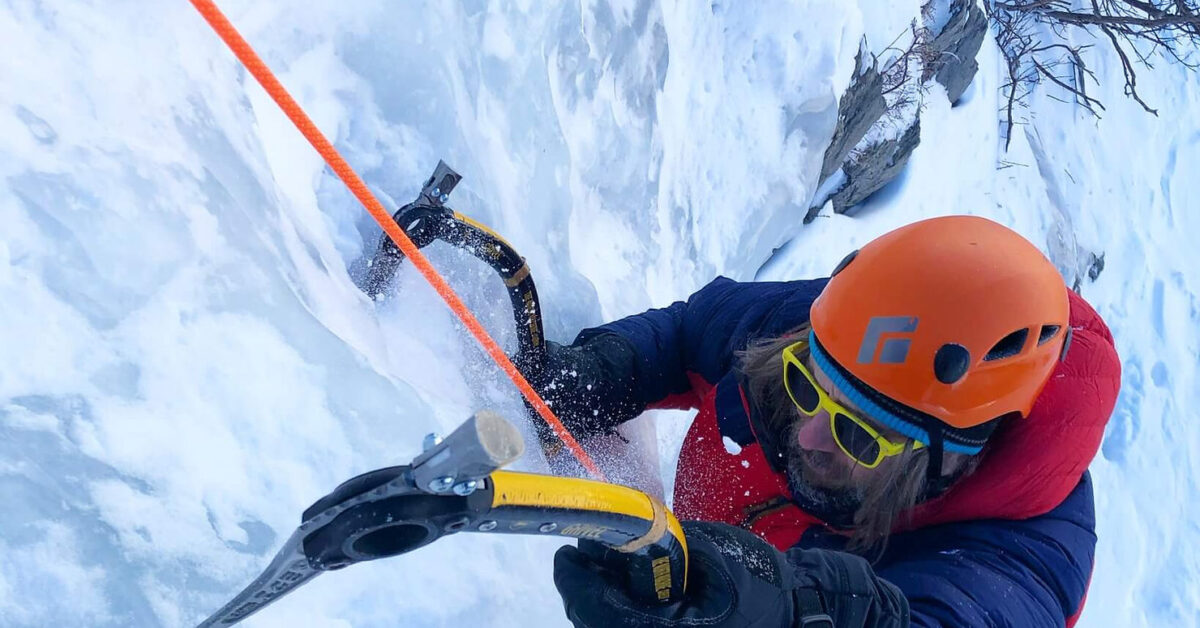
So you’ve dumped the gear bin out on the floor and started putting together gear for ice climbing. You look at the pile of equipment with a confused look and scratch your head. Not sure where to start packing?
Getting ready for an ice climbing trip can seem daunting. The sheer amount of gear required can be overwhelming and you definitely don’t want to be cold or have gear that is from the stone age. I’ve been climbing for 21 years and guiding ice for the last eleven years and love taking people out to swing the tools. Over that time, I’ve really honed in on the gear necessary to have a great day out.
Why Is Having the Right Gear So Important?
Don’t know where to start packing? I’ve got you covered!
Psyched on Ice and Ready to Climb Something Epic?
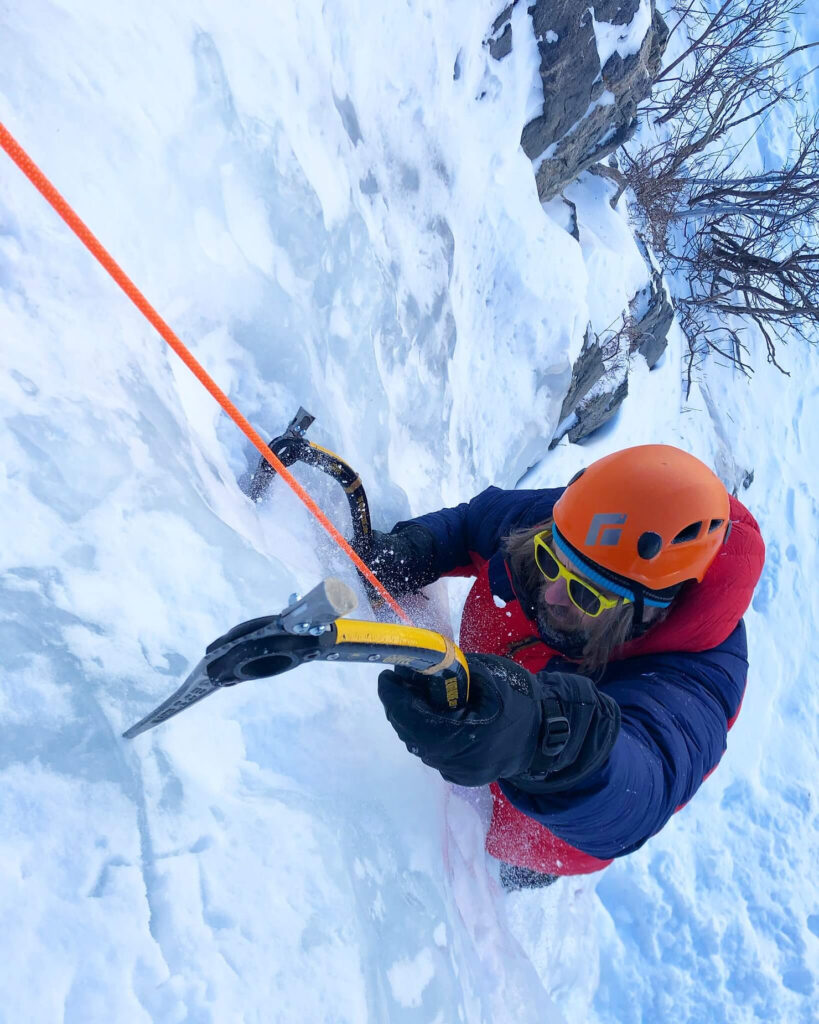
Having the right gear makes a world of difference, whether you are just getting into the sport or have been ice climbing for a long time. Ever hear that old saying, “There’s no such thing as bad weather, only bad gear”?
Given the fact that ice climbing takes place in the dead of winter on shady north facing slopes, this saying has always resonated deeply with me. I know from experience that not being prepared for the elements can make a fun day out turn into things only nightmares are made of.
So what does having the right ice climbing gear do for you?
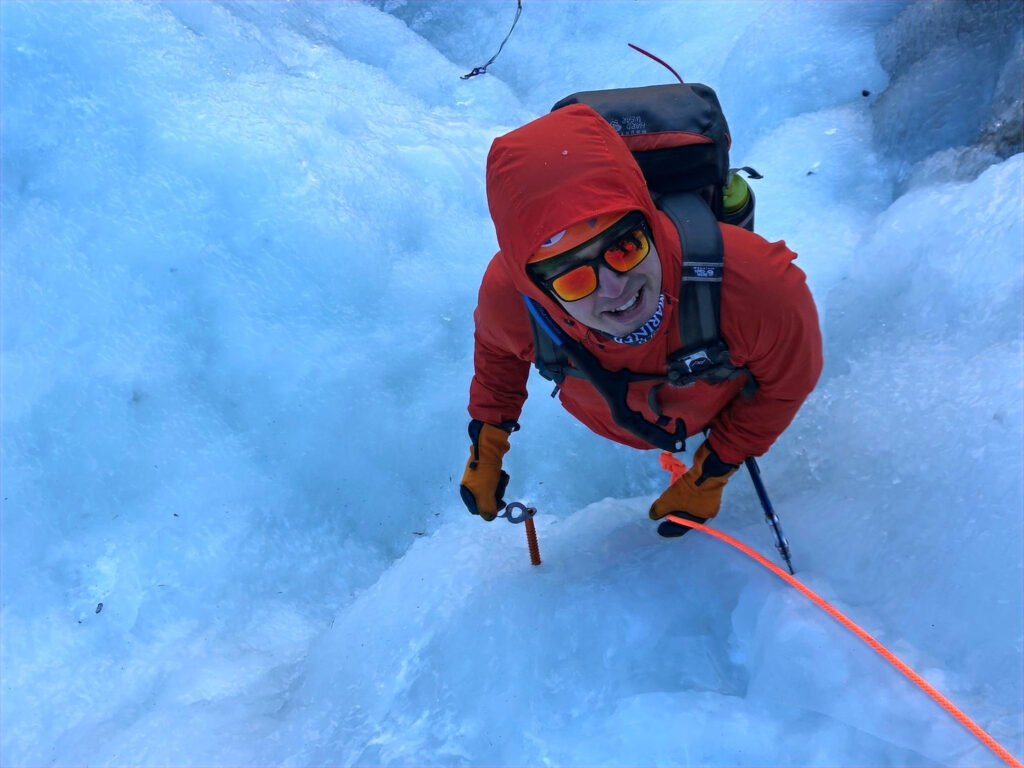
Here is my recommendation on what gear to pack for ice climbing.

Socks
Wool socks are my go to for ice climbing. In Colorado, I typically prefer thinner wool socks. Some people use liner socks, but I have always found my feet get colder if I choose to wear one. My absolute favorite socks are Smartwool. For routes with longer approaches, I bring an extra pair to change into before climbing to keep my feet warm and dry. Don’t bring cotton!

Top Baselayers
I always wear two different baselayers of varying thickness. I wear a tight fitting layer close to my skin and a looser fitting layer on top. One layers wicks moisture away while the other insulates! Synthetic baselayers work the best. Any sporting goods store will have layers that will work great.

Bottom Baselayers
Unless it’s well below zero, I normally wear one pair of thermal underwear. I’ve found that with a weather resistant layer on top, I stay plenty warm on even the coldest days. Of course, if I was climbing in Alaska, I might choose to wear another thicker pair of thermals in addition. Any sporting goods store will have layers that will work great.

Softshell Pants
My go to pants for ice climbing have got to be softshell! Pants like the Arc’teryx Gamma MX are awesome and hold up to the day to day beating of ice climbing while keeping a slim fit to prevent crampon snags. It’s important to remember that you need these pants big enough to accomodate other layers.

Hat
This one’s pretty easy. Choose a hat that has a slim fit and can easily fit under a helmet. Hats with big poof balls on the top don’t work great.

Buff or Neck Gaiter
This is arguably one of the most versatile layers you can bring into the outdoors. It can double for a hat, work as a gaiter to protect your face, or keep the sun off your neck. On really cold days, I wear this under my hat to keep my head a little warmer.

Midweight Fleece
I love a lot of the new athletic fleece type jackets and they do a great job at trapping heat. Jackets with softshell stretchy material for the arms are key, especially because we use our arms a ton while swinging our tools. My absolute favorite has got to be the Rab Capacitor Hoody.

Down Vest
A warm down vest is essential on the really cold days. If it is below 15℉, then you can bet I’m wearing this 650 fill oven! This layer goes over my midweight fleece and keeps in a ton of heat. When my core is warm, my toes are warm! I found this super lightweight and packable Eddie Bauer down vest at an outlet store for less than $50.

Synthetic Midlayer
Anytime the temps begin to dip, you can bet I have this layer on or packed in my bag. Any layer like the Arc’teryx Atom Hoody makes a great choice when layering. This incredibly light jacket is normally my last insulating layer before my shell. Oh, and the color is cool too!

Outer Shell
As the first line in defense against the elements, it’s imperative that the shell you choose can stand up to the job. My go to is normally a softshell jacket. I don’t normally bring a hardshell jacket unless the weather is really looking poor the day. The athletic fit of a jacket like Rab’s Kinetic Alpine 2.0 keeps all your layers tucked neatly under your harness and close to your body.

Belay Puffy
Bring on the warmth! A super puffy coat is just the ticket to keep you from shivering at the belay or while learning how to build ice anchors. Down puffies are always preferable as they have a higher insulating value and tend to pack down smaller. My favorite for most days out is Rab’s Zero G coat.

Gloves
I normally bring four different pairs of gloves with me. From L to R > thin gloves for mixed climbing, all around leather work gloves for rope work, thicker sticky palmed ice gloves for when the temps start to drop, thick belay gloves. Each glove has progressively more insulation than the last.

Mountaineering Boots
Having the right boots is critical to a fun day out ice climbing. I size my boots up by about a full size to ensure I have adequate wiggle room for my toes. Make sure the boots have both a front and back welt for automatic crampons. In the lower 48 states, you can get by with single boots. As you get higher in elevation or colder in temps, double boots are nice.

Crampons
Sharp pointy things on your feet! Choose an automatic style of crampon for the most secure attachment to your boot. For pure ice routes, I prefer dual points. Only when the route demands mixed climbing will I swap out for mono points. The Petzl Darts are my favorite crampon on the market right now. They just climb so well!

Ice Tools
The quintessential piece of ice climbing gear! Modern ice tools make climbing easy with features like offset handles, pommels and curved shafts, and picks with head weights. For pure waterfall ice, I choose the Petzl Nomics.

Climbing Harness
Any harness designed for rock climbing will work, however, some harnesses made specifically for ice climbing have slots where you can attach ice clippers. Ski mountaineering harnesses aren’t a great choice because they don’t have any padding around the waist. Adjustable leg loops can be nice to accomodate all those extra layers!

Climbing Helmet
There is always some sort of falling debris while ice climbing and choosing a helmet that keeps your head safe is key. Make sure it is adjustable to accomodate your hat and or buff. Many new helmets like the Petzl Sirocco are so lightweight it’s easy to forget you’re wearing one!

Backpack(s)
If I’m cragging ice, I opt for one 40L pack. If I’m planning to climb a bigger objective, I use the two backpack system. No matter how big or small (12L) my pack is, I like to have ice tool attachment points, zippers that are big enough to open with gloves, and one main top loading compartment. Blue Ice makes some great packs.

Belay Device and Locking Carabiners
A belay device is necessary for belaying your partner and rappelling a bigger route. I normally use a pear shaped carabiner with my device. The CAMP Nimbus is really nice. A spare locking carabiner can be used to attach to an anchor or personal tether.

Avalanche Gear
Many ice routes venture well off the beaten path and avalanche danger can be a major concern. If you are going to the backcountry ice, make sure to bring an avalanche beacon, shovel, and probe.

Creature Comforts
My favorite! A thermos full of something warm and yummy is more than enough to make you smile and keep you going on a cold day. I go between miso soup, chicken broth, chai tea, and coffee. Some people even put hot Jello in their thermos for a major sugar boost!

Water
Depending on my objective, I bring one to two liters of water of room temperature water. They say hot water freezes faster than cold water due to the Mpemba Effect (this is debated). Hard-sided water bottles don’t freeze as easy as bladder systems though, even if they are a little warm to begin with. I insulate my water with any spare layers I’m not actively wearing.
.

Food
This one’s easy. Bring lots of high energy snacks that are easy to eat. Jerky, dried fruit, nuts, bars, etc. Some of my favorite go to snacks are baby food packs like applesauce. I like to bring a few cough drops or Jolly Ranchers to suck on throughout the day so I don’t lose my voice in the cold air.

Personal Items
Lip balm, sunscreen, headlamp, extra batteries, and wag bag are all important items to have. Don’t forget any personal medications or your camera.

Sunglasses
This is a key piece of gear. Polarized lenses work well in protecting your eyes from both the sun and falling ice.

Trekking Pole
Trekking poles are great for longer approaches and help with balance over rough terrain. Choose a pole that is adjustable and has a solid snow basket on the end.
Ice climbing has got to be one of the very best winter sports there is! There, I said it! 😀 Once you’ve caught the bug, there’s no going back!
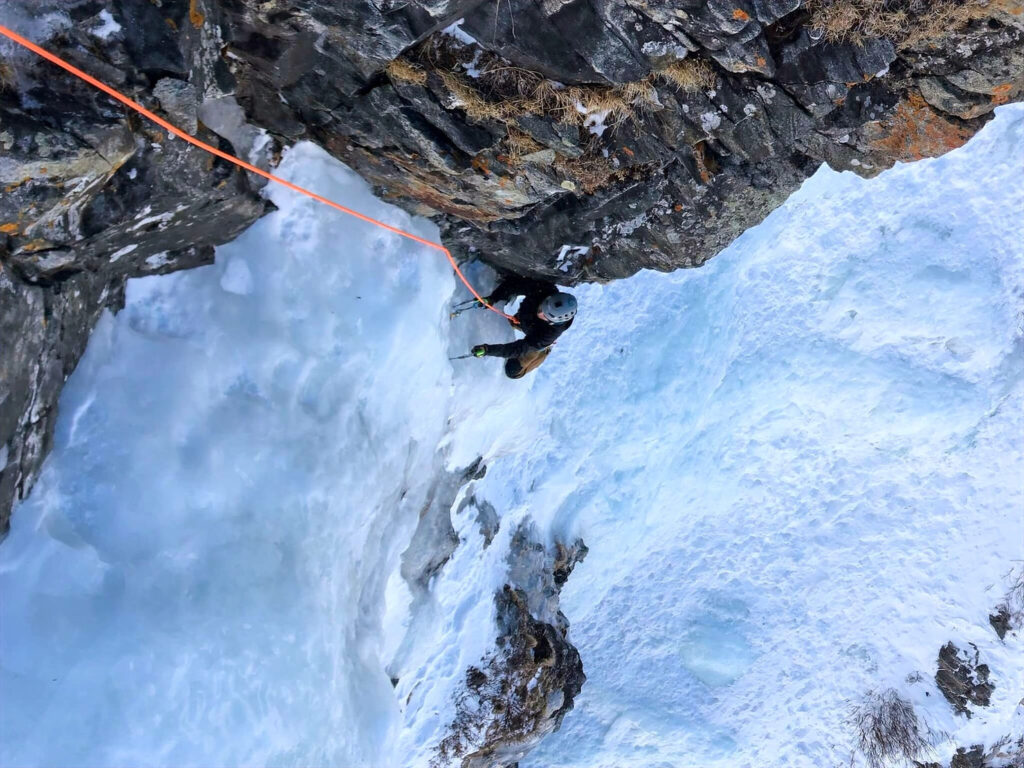
Are you looking for a bigger ice day? Something a little steeper? Golden Mountain Guides offers many different ice climbing courses as well as privately guided days.
Golden Mountain Guides even guides at the Lake City Ice Park, Lincoln Falls, and Rocky Mountain National Park!



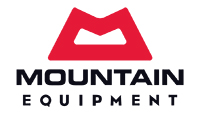
Content Copyright © 2025 of Golden Mountain Guides. All rights reserved. | Privacy Policy | Site Map